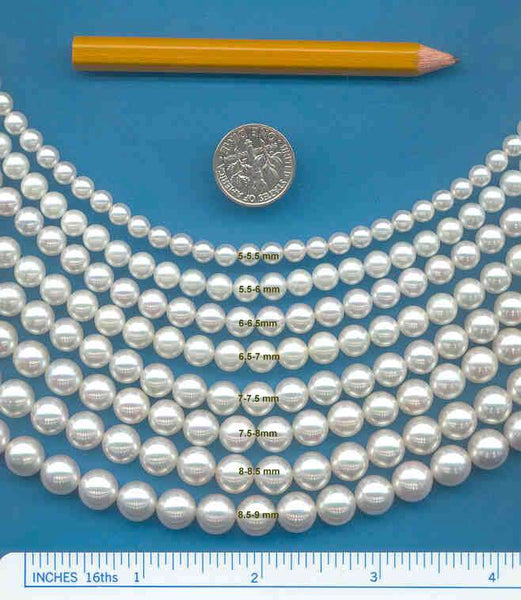
Have you ever wondered if it's worth getting a slightly larger pearl (or any other round bead) than originally planned? Have you ever questioned whether paying more for that small size difference is worth it, and if it will even be noticeable?
When it comes to pearls, the diameter (size in millimeters) doesn't tell the whole story and can be misleading when deciding which size to choose. So, let's dive into what really matters: the volume.

Why focus on volume instead of diameter? It's simple! Pearls are three-dimensional gems, not just flat circles on a picture. Volume is the key that unlocks their true essence in three-dimensional space. It determines how much space they occupy, their visual impact, and even their weight.
By understanding the volume of pearls, you can compare different sizes more accurately. It gives you a clear picture of how much larger (and heavier) one pearl will be compared to another.
This principle applies to strands of pearls as well. You can calculate the ratio by dividing the volume of the larger pearl by the volume of the smaller pearl. For strands, you can compare the volumes of the end and central pearls of two strands and find their average.

Now, let's have some fun exploring the volumes of pearls in various sizes! Please keep in mind that these numbers are rounded to the nearest whole number.
- 16mm pearl: 2144 mm³ (21% larger than a 15mm pearl, and three times larger than an 11mm pearl!)
- 15mm pearl: 1766 mm³ (23% larger than a 14mm pearl)
- 14mm pearl: 1436 mm³ (25% larger than a 13mm pearl, twice as large as an 11mm pearl, and more than five times larger than an 8mm pearl!)
- 13mm pearl: 1150 mm³ (27% larger than a 12mm pearl)
- 12mm pearl: 904 mm³ (30% larger than an 11mm pearl, and a whopping 73% larger than a 10mm pearl. It's also three times larger than an 8mm pearl!)
- 11mm pearl: 697 mm³ (33% larger than a 10mm pearl)
- 10mm pearl: 523 mm³ (37% larger than a 9mm pearl, and a remarkable 95% larger than an 8mm pearl!)
- 9mm pearl: 382 mm³ (43% larger than an 8mm pearl, and twice as large as a 7mm pearl!)
- 8mm pearl: 268 mm³ (49% larger than a 7mm pearl)
- 7mm pearl: 180 mm³ (59% larger than a 6mm pearl)
- 6mm pearl: 113 mm³ (74% larger than a 5mm pearl)
- 5mm pearl: 65 mm³
As you can see, the volume differences between pearl sizes are quite significant. It's not just about the diameter; it's about the overall visual impact and weight. So, when choosing pearls, keep in mind their volume. It will give you a better understanding of how much larger or smaller a pearl is compared to another, and help you make an informed decision.
Now you can appreciate the subtle yet impactful variations in pearl sizes. So go ahead, have fun exploring the world of pearls, and let their volumes guide you to find the perfect gem for your collection!
Note: When it comes to pearls, the impact of increasing the size by 1mm is more noticeable with smaller pearls than larger ones. This is because 1mm represents a larger percentage of the overall size of a small pearl compared to a larger one.
You can easily calculate the volume of a pearl using its diameter, even for half sizes. Here's an example using a 7mm pearl:
To calculate the volume, we use the formula for the volume of a sphere: 4/3 π (radius cubed).
Start by dividing the diameter by 2 to get the radius. For a 7mm pearl, the radius is 3.5mm. Next, find the cube of the radius (3.5 x 3.5 x 3.5 = 43mm, rounded). Multiply this result by π (43 x 3.14 = 135). Then, multiply that result by 4 and divide by 3 (135 x 4 = 540 : 3 = 180). The final result is the volume of the pearl, rounded to cubic millimeters. In this case, a 7mm pearl has an approximate volume of 180 mm³.
Understanding the volume difference is quite useful for comparing sizes and visualizing how much larger or smaller one pearl is compared to another or any other spherical beads.
To compare two pearl sizes, divide the volume of the larger pearl by the volume of the smaller pearl.
For example, let's compare an 8mm pearl to a 7mm pearl: Divide the volume of the 8mm pearl (268 mm³) by the volume of the 7mm pearl (180 mm³) = 1.49. So, the 8mm pearl is almost 1.5 times larger than the 7mm pearl, or in other words, it has a 49% greater volume, which means it weighs one and a half times more.
Now, let's consider a strand of 10-12mm graded pearls compared to a strand of 9-11mm pearls: the 12mm pearl is 30% larger than the 11mm pearl, which means the central pearls in the 10-12mm strand will be 30% larger. The 10mm pearl is 37% larger than the 9mm pearl, so the end pearls in the 10-12mm strand will be 37% larger. Taking the average of 37% and 30%, we get 33.5%. Therefore, the 10-12mm strand will be approximately one-third larger and heavier than the 9-11mm strand.
You can apply this method to compare any two strands, but remember that it provides an approximation as some strands may have a single large pearl in the center or a few smaller pearls on the ends. Nevertheless, it offers a realistic idea of their relative sizes.
In conclusion, choosing a strand that is just 1mm larger can make a significant difference in terms of size, weight, and overall appearance. However, if you opt for a longer strand, keep in mind the potential increase in weight. But hey, we don't want a strained neck. 🙂

